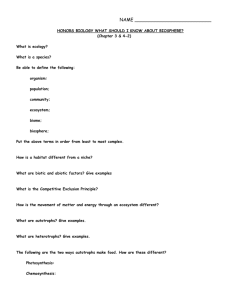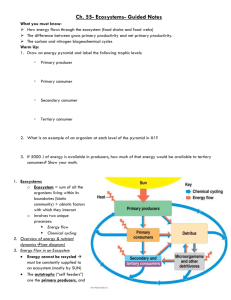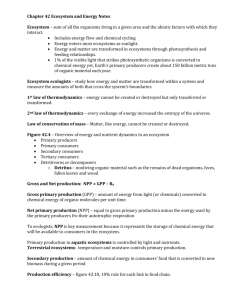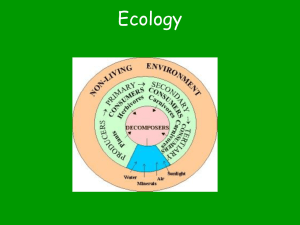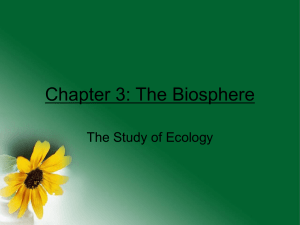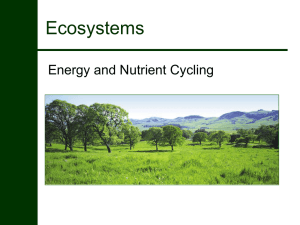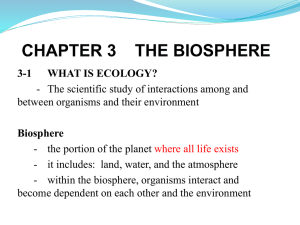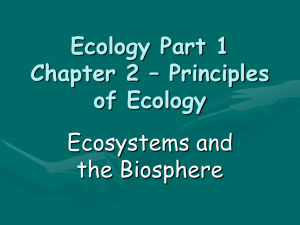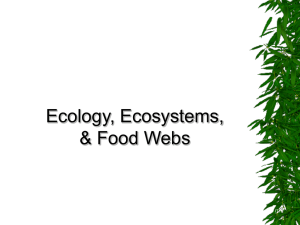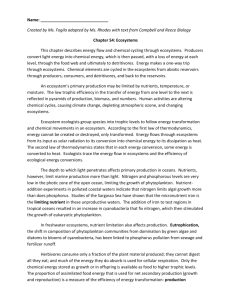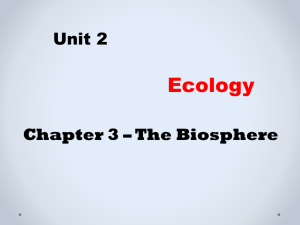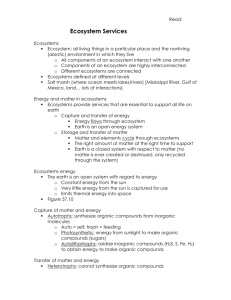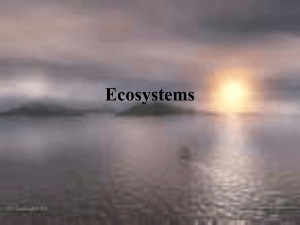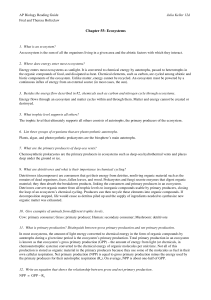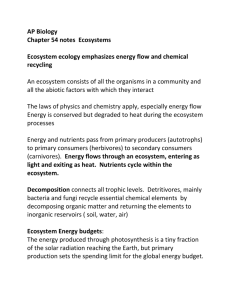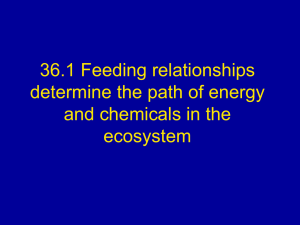Ch 54 Reading Guide Answer Key
advertisement
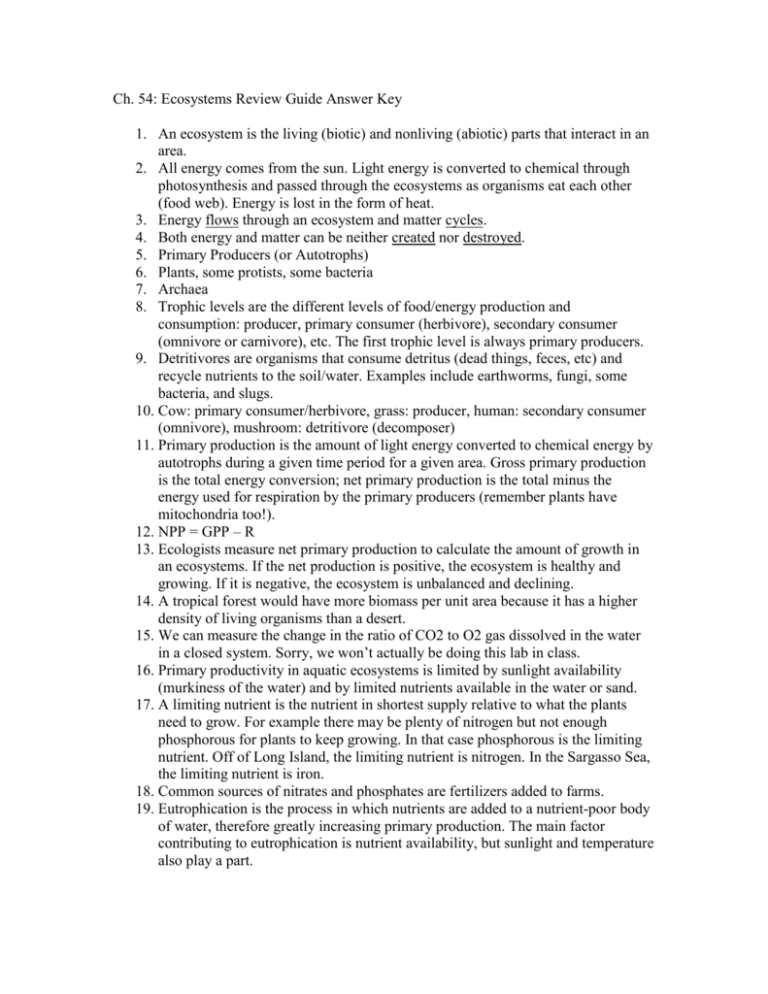
Ch. 54: Ecosystems Review Guide Answer Key 1. An ecosystem is the living (biotic) and nonliving (abiotic) parts that interact in an area. 2. All energy comes from the sun. Light energy is converted to chemical through photosynthesis and passed through the ecosystems as organisms eat each other (food web). Energy is lost in the form of heat. 3. Energy flows through an ecosystem and matter cycles. 4. Both energy and matter can be neither created nor destroyed. 5. Primary Producers (or Autotrophs) 6. Plants, some protists, some bacteria 7. Archaea 8. Trophic levels are the different levels of food/energy production and consumption: producer, primary consumer (herbivore), secondary consumer (omnivore or carnivore), etc. The first trophic level is always primary producers. 9. Detritivores are organisms that consume detritus (dead things, feces, etc) and recycle nutrients to the soil/water. Examples include earthworms, fungi, some bacteria, and slugs. 10. Cow: primary consumer/herbivore, grass: producer, human: secondary consumer (omnivore), mushroom: detritivore (decomposer) 11. Primary production is the amount of light energy converted to chemical energy by autotrophs during a given time period for a given area. Gross primary production is the total energy conversion; net primary production is the total minus the energy used for respiration by the primary producers (remember plants have mitochondria too!). 12. NPP = GPP – R 13. Ecologists measure net primary production to calculate the amount of growth in an ecosystems. If the net production is positive, the ecosystem is healthy and growing. If it is negative, the ecosystem is unbalanced and declining. 14. A tropical forest would have more biomass per unit area because it has a higher density of living organisms than a desert. 15. We can measure the change in the ratio of CO2 to O2 gas dissolved in the water in a closed system. Sorry, we won’t actually be doing this lab in class. 16. Primary productivity in aquatic ecosystems is limited by sunlight availability (murkiness of the water) and by limited nutrients available in the water or sand. 17. A limiting nutrient is the nutrient in shortest supply relative to what the plants need to grow. For example there may be plenty of nitrogen but not enough phosphorous for plants to keep growing. In that case phosphorous is the limiting nutrient. Off of Long Island, the limiting nutrient is nitrogen. In the Sargasso Sea, the limiting nutrient is iron. 18. Common sources of nitrates and phosphates are fertilizers added to farms. 19. Eutrophication is the process in which nutrients are added to a nutrient-poor body of water, therefore greatly increasing primary production. The main factor contributing to eutrophication is nutrient availability, but sunlight and temperature also play a part. 20. Trophic efficiency is the percentage of energy (production) that is transferred from one trophic level to the next. 21. 10% (Can be about 5-20% depending on the organism) 22. 1% 23. The second pyramid is inverted because the primary producers do not have more biomass than the consumers, but they can reproduce fast enough to support the consumers without going extinct. 24. Eating low on the food chain is more energy efficient. By cutting out the middle steps in a food pyramid, a higher percentage of the sun’s energy goes directly to the humans. 25. Label the picture according to p. 1196. 26. Photosynthesis: CO2 + H20 C6H12O6 + O2 Cellular Respiration C6H12O6 + O2 CO2 + H20 27. Label the pictures according to p. 1196-1197. 28. DO NOT COMPLETE 29. Fertilizers have put more nitrogen into both terrestrial ecosystem and messed with the balance of the nitrogen cycle and primary production. 30. Human production of CO (carbon monoxide) in factories combines with water to produce carbonic acid and make acid rain. Acid rain ruins crops and can erode metal structures. 31. Biological magnification (or bioaccumulation) is when toxic chemicals build up as they are consumed in small amounts by lower-food chain organisms then accumulate in higher concentrations in higher-food chain organisms. One example is the concentration of PCBs in marine organisms and birds. 32. The greenhouse effect is the warming of the earth by the gasses in the earth’s atmosphere trapping radiant energy (from the sun) from being reflected back into space. Without it the earth would freeze and not be able to support life. 33. The increase in atmospheric carbon dioxide comes from humans burning fossil fuels in factories and cars. It increases the greenhouse effect, trapping more of the sun’s energy in the atmosphere, and increasing the amount of energy in the earth’s system (unusual weather, more extreme storms, etc.). 34. Ozone in the atmosphere is depleted by the accumulation of CFCs in the atmosphere. Without ozone, life in earth is not as protected from UV radiation from the sun, which can lead to skin cancer and killing crops (among other things).
